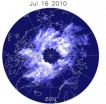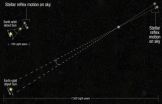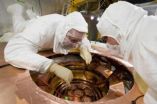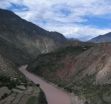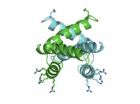(Press-News.org) First spotted in 1885, silvery blue clouds sometimes hover in the night sky near the poles, appearing to give off their own glowing light. Known as noctilucent clouds, this phenomenon began to be sighted at lower and lower latitudes -- between the 40th and 50th parallel -- during the 20th century, causing scientists to wonder if the region these clouds inhabit had indeed changed -- information that would tie in with understanding the weather and climate of all Earth.
A NASA mission called Aeronomy of Ice in the Mesosphere, or AIM, was launched in 2007 to observe noctilucent clouds, but it currently only has a view of the clouds near the poles. Now scientists have gathered information from several other missions, past and present, and combined it with computer simulations to systematically show that the presence of these bright shining clouds have indeed increased in areas between 40 and 50 degrees north latitude, a region which covers the northern third of the United Sates and the lowest parts of Canada. The research was published online in the Journal of Geophysical Research: Atmospheres on March 18, 2014.
"Noctilucent clouds occur at altitudes of 50 miles above the surface -- so high that they can reflect light from the sun back down to Earth," said James Russell, an atmospheric and planetary scientist at Hampton University in Hampton, Va., and first author on the paper. "AIM and other research has shown that in order for the clouds to form, three things are needed: very cold temperatures, water vapor and meteoric dust. The meteoric dust provides sites that the water vapor can cling to until the cold temperatures cause water ice to form."
To study long-term changes in noctilucent clouds, Russell and his colleagues used historical temperature and water vapor records and a validated model to translate this data into information on the presence of the clouds. They used temperature data from 2002 to 2011 from NASA's Thermosphere Ionosphere Mesosphere Energetics and Dynamics, or TIMED, mission and water vapor data from NASA's Aura mission from 2005 to 2011. They used a model previously developed by Mark Hervig, a co-author on the paper at GATS, Inc., in Driggs, Idaho.
The team tested the model by comparing its output to observations from the Osiris instrument on the Swedish Odin satellite, which launched in 2001, and the SHIMMER instrument on the U.S. Department of Defense STPSat-1 mission, both of which observed low level noctilucent clouds over various time periods during their flights. The output correlated extremely well to the actual observations, giving the team confidence in their model.
The model showed that the occurrence of noctilucent clouds had indeed increased from 2002 to 2011. These changes correlate to a decrease in temperature at the peak height where noctilucent clouds exist in the atmosphere. Temperatures at this height do not match temperatures at lower levels – indeed, the coldest place in the atmosphere is at this height during summertime over the poles – but a change there certainly does raise questions about change in the overall climate system.
Russell and his team will research further to determine if the noctilucent cloud frequency increase and accompanying temperature decrease over the 10 years could be due to a reduction in the sun's energy and heat, which naturally occurred as the solar output went from solar maximum in 2002 to solar minimum in 2009.
"As the sun goes to solar minimum, the solar heating of the atmosphere decreases, and a cooling trend would be expected," said Russell.
INFORMATION:
NASA's Goddard Space Flight Center in Greenbelt, Md. manages the TIMED mission for the agency's Science Mission Directorate at NASA Headquarters in Washington. The spacecraft was built by the Johns Hopkins University Applied Physics Laboratory in Laurel, Md.
Appearance of night-shining clouds has increased
2014-04-10
ELSE PRESS RELEASES FROM THIS DATE:
NASA simulation portrays ozone intrusions from aloft
2014-04-10
Outdoor enthusiasts in Colorado's Front Range are occasionally rewarded with remarkable visibility brought about by dry, clear air and wind. But it's what people in the mountainous U.S. West can't see in conditions like this – ozone plunging down to the ground from high in the stratosphere, the second layer of the atmosphere – that has attracted the interest of NASA scientists, university scientists and air quality managers.
Ozone in the stratosphere, located on average 10 to 48 kilometers (6 to 30 miles) above the ground, typically stays in the stratosphere. Not on days ...
NASA's Hubble extends stellar tape measure 10 times farther into space
2014-04-10
Using NASA's Hubble Space Telescope, astronomers now can precisely measure the distance of stars up to 10,000 light-years away -- 10 times farther than previously possible.
Astronomers have developed yet another novel way to use the 24-year-old space telescope by employing a technique called spatial scanning, which dramatically improves Hubble's accuracy for making angular measurements. The technique, when applied to the age-old method for gauging distances called astronomical parallax, extends Hubble's tape measure 10 times farther into space.
"This new capability ...
SU plays key role in search for elusive dark matter
2014-04-10
Physicist Richard Schnee hopes to find traces of dark matter by studying particles with low masses and interaction rates, some of which have never been probed before.
The ongoing search for invisible dark matter is the subject of a recent article involving physicists from Syracuse University's College of Arts and Sciences.
Research by Richard Schnee, assistant professor of physics, is referenced in Symmetry magazine, a joint publication of the Stanford Linear Accelerator Center in Palo Alto, Calif., and Fermilab in Batavia, Ill.
"Scientists looking for dark matter ...
SU geologists prove early Tibetan Plateau was larger than previously thought
2014-04-10
Earth scientists in Syracuse University's College of Arts and Sciences have determined that the Tibetan Plateau—the world's largest, highest, and flattest plateau—had a larger initial extent than previously documented.
Their discovery is the subject of an article in the journal Earth and Planetary Science Letters (Elsevier, 2014).
Gregory Hoke, assistant professor of Earth sciences, and Gregory Wissink, a Ph.D. student in his lab, have co-authored the article with Jing Liu-Zeng, director of the Division of Neotectonics and Geomorphology at the Institute for Geology, ...
SU professors test boundaries of 'new physics' with discovery of 4-quark hadron
2014-04-10
Physicists in Syracuse University's College of Arts and Sciences have helped confirm the existence of exotic hadrons—a type of matter that cannot be classified within the traditional quark model.
Their finding is the subject of a forthcoming article, prepared by the Large Hadron Collider beauty (LHCb) Collaboration at CERN in Geneva, Switzerland. (LHCb is a multinational experiment, designed to identify new forces and particles in the universe.) Tomasz Skwarnicki, professor of physics, is one of the paper's lead authors.
"We've confirmed the unambiguous observation ...
ACP offers policy recommendations for reducing gun-related injuries, deaths in US
2014-04-10
April 10, 2014 -- A new policy paper from the American College of Physicians (ACP) offers nine strategies to address the societal, health care, and regulatory barriers to reducing firearms-related violence, injuries, and deaths in the United States. Reducing Firearm-Related Injuries and Deaths in the United States is published today in the peer-reviewed medical journal, Annals of Internal Medicine.
Principal among ACP's nine strategic imperatives is the recommendation to approach firearm safety as a public health issue so that policy decisions are based on scientific ...
Single mothers don't delay marriage just to boost tax credit, study says
2014-04-10
MADISON, Wis. – When the Earned Income Tax Credit was expanded in 1993, supporters hoped it would reward poor parents for working while critics feared that it might discourage single mothers from marrying or incentivize women to have more children to boost their tax refund.
A new collaborative study done by the University of Wisconsin-Madison and Cornell University reveals the EITC has helped the working poor but hasn't affected personal choices.
Sarah Halpern-Meekin, assistant professor of human development and family studies and affiliate of the Institute for Research ...
Antennae help flies 'cruise' in gusty winds
2014-04-10
Due to its well-studied genome and small size, the humble fruit fly has been used as a model to study hundreds of human health issues ranging from Alzheimer's to obesity. However, Michael Dickinson, Esther M. and Abe M. Zarem Professor of Bioengineering at Caltech, is more interested in the flies themselves—and how such tiny insects are capable of something we humans can only dream of: autonomous flight. In a report on a recent study that combined bursts of air, digital video cameras, and a variety of software and sensors, Dickinson and his team explain a mechanism for ...
Enzyme revealed as promising target to treat asthma and cancer
2014-04-10
In experiments with mice, Johns Hopkins Kimmel Cancer Center scientists have identified an enzyme involved in the regulation of immune system T cells that could be a useful target in treating asthma and boosting the effects of certain cancer therapies.
In research described online April 6 in Nature Immunology, the investigators show that mice without the enzyme SKG1 were resistant to dust mite-induced asthma. And mice with melanoma and missing the enzyme, developed far fewer lung tumors—less than half as many—than mice with SKG1.
"If we can develop a drug that blocks ...
Researchers discover possible new target to attack flu virus
2014-04-10
Scientists at The University of Texas at Austin have discovered that a protein produced by the influenza A virus helps it outwit one of our body's natural defense mechanisms. That makes the protein a potentially good target for antiviral drugs directed against the influenza A virus.
Better antiviral drugs could help the millions of people annually infected by flu, which kills up to 500,000 people each year.
When an influenza virus infects a human cell, it uses some of the host's cellular machinery to make copies of itself, or replicate. In this study, the researchers ...
